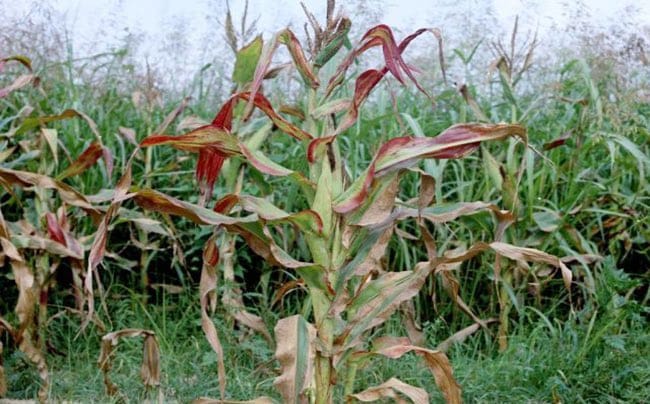
Some corn crops in Argentina are under severe disease pressure this season which is cutting yield prospects. Photo: Agroverdad
ARGENTINA’S corn-production forecasts are being adjusted drastically lower as the crop, which only a month ago was widely expected to be a record, battles a rare leafhopper plague. This sap-sucking pest is also a vector for the highly pathogenic crop disease known as spiroplasma.
More commonly known as corn stunt disease, it can decimate the maturing corn plant, resulting in weighty yield penalties and even complete crop failure in severe outbreaks. Characterised by the development of small ears with missing kernels and reduced kernel weights, the disease poses a considerable threat to crop yields. Compounding the challenge is the difficulty in visually identifying infected fields from a distance, making mitigation efforts arduous.
The corn leafhopper is endemic in northern Argentina and appears to have built numbers in the past three hot and dry La Niña years. This season’s favourable environmental conditions have led to the worst infestation in recent memory in the northern provinces and the worst ever for central Argentina. Add an extremely wet and humid April, and ideal conditions for pathogenesis of corn stunt disease on plants infected by the leafhopper, and the potential production impact is dire.
In the hardest-hit northern provinces of Chaco, Santiago del Estero, and Tucumán, the losses caused by the disease generally range from 40-50 percent, when it would typically be 5pc at worst. It has also been found in regions further south, such as Santa Fe and Cordoba, where it has not previously been a problem.
Pre-plant seed treatment wanting
In response to the devastating outbreak, the government announced earlier in April that it was fast-tracking the approval process for two new insecticides recommended to combat the spiroplasma disease. However, the move comes too late to have a material impact on the current crop-production cycle.
Once the crop is infested with leafhoppers, it is almost impossible for foliar applications to curb the spread. The corn seed must be treated with a systemic insecticide before planting to protect the young seedlings, and the crop needs to be sprayed post-emergence with an insecticide to control the insects and the corn stunt disease they carry.
Nighttime temperatures are another factor that will further influence the spread of the disease, as the leafhopper cannot survive in temperatures below 4 degrees Celsius. However, current weather forecasts suggest temperatures that low are unlikely in the near term, especially in the worst-hit areas in the north of the country.
Vagary of nature
Farmers across Argentina are already concerned about the potential impact on 2024/25 production, as the leafhopper does not die off once the corn is harvested. Instead, it looks for host plants, such as wheat, oats, barley, rye, grasses and other pastures, in which it can survive and breed over the winter before attacking again next summer when the corn crop emerges. If it is a warm winter, survival rates and next season’s risk will be high, but the leafhopper’s life cycle will be seriously curbed if it is cold.
To add insult to injury, it has been extremely wet across much of the country over the past month. Many regions have had upwards of 200 millimetres in the last 30 days. While this has been good for the later planted summer crops and the soil moisture profile for the upcoming winter crop planting program, it has slowed summer crop maturity, delayed the harvest, damaged the ripened crops and been ideal for fostering pest and disease pressure.
After a string of crop failures due to a devastating multi-year drought, farmer optimism was running high in the world’s third-biggest corn exporter, as near perfect weather conditions led to predictions that the 2024 harvest would break the record 52 million tonnes harvested in 2020.
Analyst clips 10 percent
The USDA increased its production forecast by 1Mt to 56Mt in March, 56pc higher than the 2023 harvest, only to drop it back to 55Mt in the early April update. Respected crop analyst Michael Cordonnier entered April with a forecast of 55Mt and a neutral to slightly lower bias, but that estimate was very quickly slashed to 50Mt in the first two weeks of April as the full extent and impact of the spiroplasma infestation became apparent.
The Rosario Grain Exchange was even more bullish on corn production prospects, expecting output of 57Mt before the spiroplasma outbreak struck. It now expects corn yields to be down significantly across the country, ripping 6.5Mt out of its crop estimate in the past couple of weeks to stand at 50.5Mt.
The Buenos Aires Grain Exchange (BAGE) updated crop status and harvest progress last week and maintained its corn output estimate of 49.5Mt, down from its February projection of 56.5Mt. The corn harvest progressed by 2.6 percentage points over the week to April 24, reaching 19.8pc of the total estimated area of 7.2 million hectares, with an average yield of 8.8 metric tonne per hectare. BAGE estimates that 90pc of early plantings in the core production areas have already been harvested, with an average yield of 10.2 tons per hectare.
Only 17pc of the corn crop was rated good-to-excellent in last week’s update, down from 20pc a week earlier but up from 3pc a year earlier. Conversely, 40pc of the crop was rated poor to very poor, up from 36pc a week earlier, but still better than this time in 2023 when 52pc fell into the lowest category.
The drop in corn production will significantly impact Argentina’s 2023/24 exports, dampening President Javier Milei’s hopes of reviving the economy via an increase in agriculture oriented export income. Despite the 1Mt drop in output, the USDA maintained its export estimate of 42Mt in its April supply and demand update, an increase of 66pc compared to 2022/23. However, the May report will likely bring a sizeable downward revision to both the production and export figures, assuming the agency’s number crunchers are abreast of the issue.



HAVE YOUR SAY